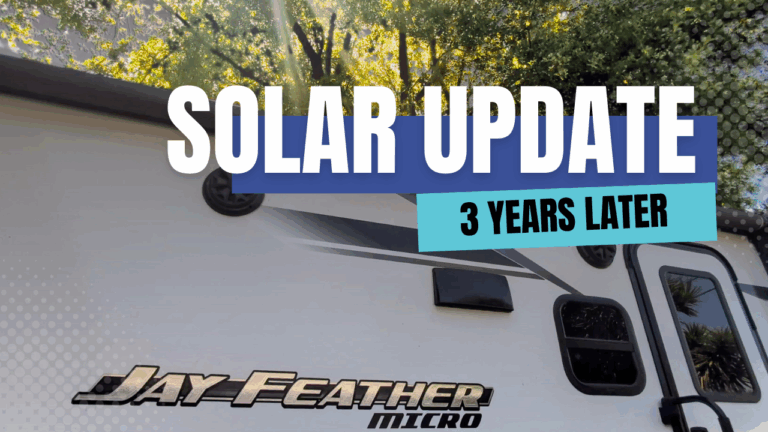Our Jayco Jay Feather Micro trailer came with the Go Power! Overlander solar kit. Now that we’ve been using it for over a year we thought we’d go over how it’s working out for us.
Rogina Roaming is supported by its audience. When you purchase through links on our site, we may earn an affiliate commission at no extra cost to you.
Our Trailer Solar System
We have the Go Power! Overlander package. It includes a 190-watt panel for the roof and a 30-amp PWM controller. And we upgraded our batteries to two 6-volt golf cart batteries.
Now, we like to camp in the shade. And that doesn’t always work out well with solar. It has been a real struggle for us to get our batteries back up to 100%. We have a Duralite 100-watt side panel and that’s worked out really well to get our batteries back up to 100%. But, it requires us moving it around and trying to chase the sun. You basically have to spend a whole day in camp to make sure that you’re moving the portable panel to the perfect spot so that you can get enough sun to charge your batteries back up.
So, we decided to add a second panel to the roof. We got the expansion panel that goes with the Go Power! Overlander set. It’s an additional 190-watt panel and it’s wired in parallel. With the two panels together we have a total of 380-watts of solar now.
We wanted to see how our system works now. So, this is a step-by-step walkthrough of how a dry camping trip went with our two 190-watt panels using our 30-amp PWM controller. It’s all part of the Go Power! Overlander package.
Testing the Solar System
For this test we were parked in partial shade. (Which is our preferred type of campsite.) We weren’t under redwood trees, but there were still tall trees and the panels were still partially shaded.
First Night at Camp
When we parked the batteries were at 100%. After just a few minutes of using the lights and the water pump, the battery went down to 87%. And then a few minutes later it was back up to 100%.
When we came in for the night, the trailer was at 73%. We did have the big awning light on the entire time we were outside. When we were all ready for bed, the batteries were reading at 80%.
The Next Day
When we woke up at 7 am the batteries were at 68%. We started getting some coffee ready so we turned on the stove to boil some water and we also turned on the light and the fan on top of the stove. The batteries went down to 66%.
They stayed at 66% all morning. We did some dishes, we turned the furnace on, we got ready, and they remained at 66%.
So, we went out on a hike and when we came back the campsite still seemed pretty shady. But, the batteries were back up to 100%. And they just stayed at 100% throughout the day.
At about 5pm we started getting back to that point where any time we turned on a light or the water pump the batteries went down to 87%. After we were done doing the dishes from dinner the batteries went down to 66%. During that time we had the water pump, the water heater, and the lights on for about 20 minutes.
When it was time for the kids to go to bed the batteries were at 70%. After that we turned on the TV and the batteries dropped down to 62%. But they stayed there the whole time we were watching TV. And in the morning we woke up and it still showed the batteries at 62%.
Another Day at Camp
As just mentioned, the batteries were at 62% when we woke up. That morning we spent a lot of time just hanging out at camp. It never really felt that sunny to us but by 10:30am the batteries were back up to 100%.
Our Opinion on the Solar System
We were really happy with the performance of the Go Power! Overlander kit with the expansion panel. The second panel was a huge help. It made it so we didn’t need to use the side panel at all, which is great because our solar on side plug actually broke off on our last camping trip and we haven’t had time to repair it yet.
So we were really happy that we were able to get our batteries back up to 100% just by using the panels on the roof.
We do still have to watch our battery consumption but that seems to have a lot more to do with our batteries than our solar setup. The batteries are 6-volt golf cart batteries and those can’t be depleted more than 50%.
The solar setup did a great job of getting our batteries back up and charged. But, there are limitations with the lead-acid golf cart batteries and that was really our drawback this trip. So that is great news and we were really happy with this upgrade.



